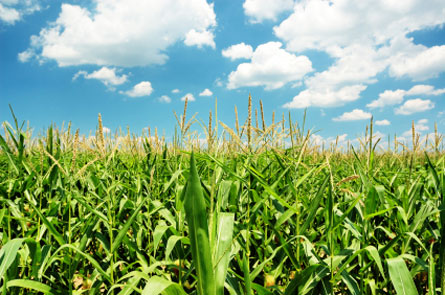Watering the air
Crop irrigation and farming practices could mean a cooler, wetter Midwest
The average temperature around the world is rising. People living in the U.S. Midwest might find this fact hard to believe, though. Two new studies show that in America’s heartland, summers are now cooler and wetter than they were in years past. The scientists suggest that the change in the Midwest climate may have happened because of farming.
The first study was led by David Changnon, a climatologist at Northern Illinois University in DeKalb. He presented one of the studies in January during a meeting of scientists who study weather and climate. A climatologist studies the climate of an area, which includes measuring rainfall, temperature and wind. Climatologists want to know how these factors have changed in the past, and how they’ll change in the future.
 |
|
Crops of soybean and corn (pictured) are the main type planted in the Midwest.
|
| Purdue9394/iStockphoto |
Changnon and his team studied temperature records from Chicago and 13 other sites in the Midwest. They found that since 1970, the average temperature in Illinois and Iowa during July and August has gone down — by up to one degree Fahrenheit — from what it was during the years between 1930 and 1969. Their investigation also showed that the average rainfall in those two states during those two months has increased. Between 1970 and 2009, about 0.33 inches more rain fell than between 1930 and 1969.
These two changes — lower temperatures and more rainfall — may be connected by humidity, Changnon says. Humidity is the measure of how much moisture is in the air. Humid air, which contains a lot of moisture, takes longer to heat up than dry air, Changnon notes. And humid air often releases its moisture through rainfall.
So where did the extra moisture in the air come from? Changnon points to farms in the region. As plants grow, they pull moisture from the ground and release it into the air. And among plants, soybean and corn plants release a lot of moisture. Midwestern farms now plant more soybeans and corn than in the past, with 97 percent of farmland today planted with these two crops. In the 1930s, corn and soybeans covered only about 57 percent, Changnon says. He also notes that the plants are planted closer together now than they used to be, so there are more plants per acre than in the past.
The second study, like Changnon’s, also found an increase in rainfall in the same area. But it points to another possible source for the increased moisture. Alan Robock of the Center for Environmental Prediction at Rutgers University in New Brunswick, N.J., was part of the team that produced the second study and presented the group’s findings at the same meeting as Changnon. The group includes Ying Fan, who led the study, and Anthony DeAngelis, M. D. Kustu and D. A. Robinson, all from Rutgers University.
The team found that irrigation practices in the Great Plains have changed over the years. (Irrigation is how farmers get water to crops, especially crops far from a river or other body of water. Irrigation is a way of bringing water to those crops all the time.) The researchers studied a vast area of the United States that stretches from South Dakota to Oklahoma and the Texas panhandle. They found that in 1930, farmers in that region irrigated only about 1.8 million acres of farmland, an amount roughly half the size of Connecticut. In 1980, however, farmers irrigated nearly 15 million acres — more land than Vermont and New Hampshire combined.
Much of this irrigation uses water from natural reservoirs, such as those that are underground. Plants use the water and then release it into the air, so irrigating more and more plants means that more and more water makes it into the air. Robock suspects that as farms in the Great Plains received more irrigation, they released more moisture into the air — which then was carried downwind to the Midwest, where it caused more rain.
These results by Changnon and Robock and his colleagues are the first step toward understanding a change in the weather. But it will take more studies before crop irrigation can definitely be blamed for changes in temperature and rainfall.
POWER WORDS
irrigate To supply (dry land) with water by means of ditches, pipes, or streams; water artificially.
acre A unit of area in the U.S. Customary System, used in land and sea floor measurement and equal to 4,840 square yards or 43,560 square feet.
humidity Dampness, especially of the air
climate The meteorological conditions, including temperature, precipitation, and wind, that characteristically prevail in a particular region.
Going Deeper:







